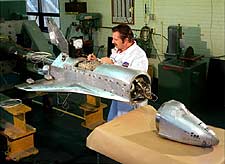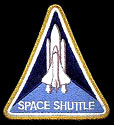 |
|
|
THE SPACE PROGRAM The Early Years The Mercury Program The Gemini Program The Apollo Program Skylab Apollo-Soyuz The Shuttle Program Program Info Orbiter Info Mission Info The Space Station Background Assembly Dog Crews Mars Missions Art |
|
 Photo by Nasa
Photo by Nasa
PHOTO: 5% Space Shuttle Control Model in 16 Foot Transonic Tunnel NASA model of the space shuttle being prepared for testing in Langley's 16 foot Transonic Tunnel. | |
| |||
In orbit, the Space Shuttles circle the earth at a speed of 17,500 miles per hour with each orbit taking about 90 minutes. A Space Shuttle crew sees a sunrise or sunset every 45 minutes. When Space Shuttle flights began in April 1981, Dryden Flight Research Center, Edwards, California, was the primary landing site for the Shuttles. Now Kennedy Space Center, Florida, is the primary landing site with Dryden remaining as the principal alternate landing site. Enterprise, the first Space Shuttle Orbiter, was rolled out of Rockwell's Air Force Plant 42, Site 1 Palmdale California assembly facility on Sept. 17, 1976. On Jan. 31, 1977, it was transported 36 miles overland from Rockwell's assembly facility to NASA's Dryden Flight Research Facility at Edwards Air Force Base for the approach and landing test program. The nine-month-long ALT program was conducted from February through November 1977 at the Dryden Flight Research Facility and demonstrated that the orbiter could fly in the atmosphere and land like an airplane, except without power-gliding flight. Following the Enterprise's success, the orbiter Columbia was created and it became the first Space Shuttle to fly into Earth orbit in 1981. Four sister ships joined the fleet over the next 10 years: Challenger, arriving in 1982 but destroyed four years later; Discovery, 1983; Atlantis, 1985; and Endeavour, built as a replacement for Challenger, 1991. |
